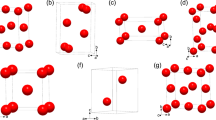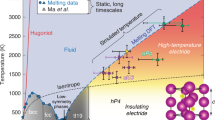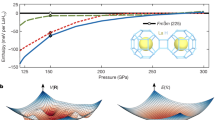Abstract
IT is well known that graphite forms lamellar compounds with potassium, rubidium and cæsium1,2, but hitherto it has seemed likely, both on experimental1–3 and theoretical4 grounds, that sodium does not behave in this way. Recent work at Harwell reported here has, however, provided evidence for the existence of a lamellar compound of sodium with graphite.
This is a preview of subscription content, access via your institution
Access options
Subscribe to this journal
Receive 51 print issues and online access
$199.00 per year
only $3.90 per issue
Buy this article
- Purchase on Springer Link
- Instant access to full article PDF
Prices may be subject to local taxes which are calculated during checkout
Similar content being viewed by others
References
Fredenhagen, K., and Cadenbach, G., Z. anorg. Chem., 158, 249 (1926).
Rudorff, W., and Schulze, E., Z. anorg. Chem., 277, 156 (1954).
Herold, A., Bull. Soc. Chim. Fr., 999 (1955).
Hennig, G. R., Proc. 1st and 2nd Conf. on Carbon, University of Buffalo, U.S.A., 103 (1956).
Author information
Authors and Affiliations
Rights and permissions
About this article
Cite this article
ASHER, R., WILSON, S. Lamellar Compound of Sodium with Graphite. Nature 181, 409–410 (1958). https://doi.org/10.1038/181409a0
Issue Date:
DOI: https://doi.org/10.1038/181409a0
This article is cited by
-
Low-temperature-pyrolysis preparation of nanostructured graphite towards rapid potassium storage with high initial Coulombic efficiency
Nano Research (2024)
-
Electrospun Flexible Nanofibres for Batteries: Design and Application
Electrochemical Energy Reviews (2023)
-
Na Adsorption on Para Boron-Doped AGNR for Sodium-Ion Batteries (SIBs): A First Principles Analysis
Journal of Electronic Materials (2022)
-
Free-standing and binder-free porous monolithic electrodes prepared via sol–gel processes
Journal of Sol-Gel Science and Technology (2022)
-
NaFeTiO4 nanorod/multi-walled carbon nanotubes composite as an anode material for sodium-ion batteries with high performances in both half and full cells
Nano Research (2017)
Comments
By submitting a comment you agree to abide by our Terms and Community Guidelines. If you find something abusive or that does not comply with our terms or guidelines please flag it as inappropriate.



